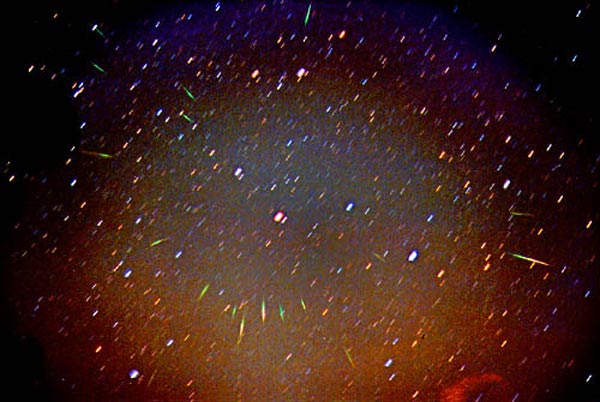Credit & Copyright: Juan Carlos Casado
Explanation:
The 1999 Leonids meteor shower was not equally good for everybody.
Only observers in Europe and the Middle East with clear skies near
2 am (UTC) on 1999 November 18 saw rates
shoot up to a meteor every few seconds.
Above, however, is a picture taken from Spain
during this time, with over a dozen faint
meteors visible as
green streaks eminating from
Leo during just
a six minute exposure.
Although more numerous, the
1999 Leonids did not have the same
high proportion of bright meteors and fireballs as the
1998 Leonids.
Last year's Leonid fireballs
have been
traced back to the 1333 passage of
Comet Tempel-Tuttle.
The orbit of Jupiter continually deflected one stream of
cast-off particles while the smallest
meteors in
this stream were removed by light pressure from the Sun.
The remaining Leonids were relatively large,
pea sized or larger, compared to the sand-sized Leonids that are more common.
1999 2000 2001 2002 2003 2004 2005 2006 2007 2008 2009 2010 2011 2012 2013 2014 2015 2016 2017 2018 2019 2020 2021 2022 2023 2024 2025 |
Январь Февраль Март Апрель Май Июнь Июль Август Сентябрь Октябрь Ноябрь Декабрь |
NASA Web Site Statements, Warnings, and Disclaimers
NASA Official: Jay Norris. Specific rights apply.
A service of: LHEA at NASA / GSFC
& Michigan Tech. U.
|
Публикации с ключевыми словами:
Leonids - meteor - meteor shower - Леониды - Метеор - Метеорный поток - метеорный дождь - комета Темпеля-Туттля
Публикации со словами: Leonids - meteor - meteor shower - Леониды - Метеор - Метеорный поток - метеорный дождь - комета Темпеля-Туттля | |
См. также:
Все публикации на ту же тему >> | |
